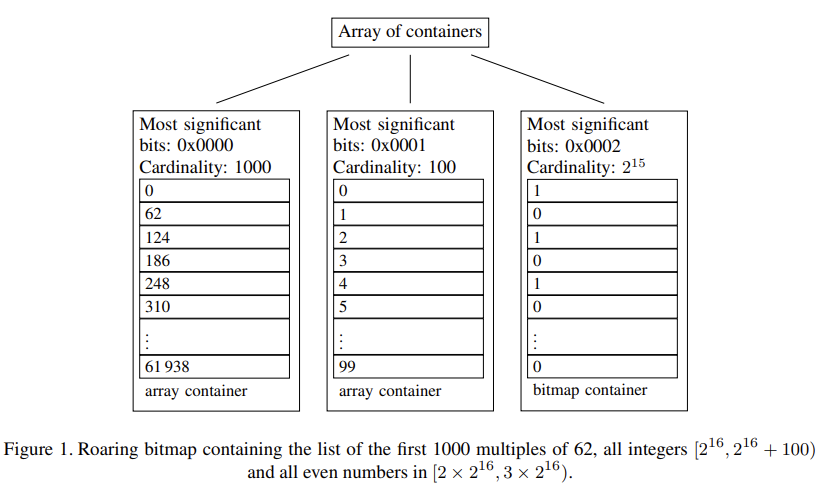TL;DR
本文提出了一种 bitmap 压缩格式 Roaring,它使用自适应的两级索引结构,分别用 bitmap 保存 dense 数据、用数组保存 sparse 数据,由此在空间占用与常见操作性能之间取得了很好的平衡。
相比 trivial 的 bitset 实现,Roaring 在内存占用,以及超稀疏场景下的操作性能上都有着明显的优势。相比基于 RLE 的 WAH 和 Concise 两种格式,它在空间占用与操作性能上都有着明显的优势。
Roaring 属于是一看就觉得 make sense,早该如此的 idea。
Background
bitmap 属于是超经典数据结构了。我们对 bitmap 的要求有:
- 空间占用,可以按 bit per element 来衡量。
- 常见操作的性能:
- union
- intersect
- n-th element
- count
最 trivial 的 bitmap 实现就是各种语言基本都带的 bitset。它的缺点是空间占用与元素密度成反比,当元素非常稀疏时空间占用太大。
Roaring 之前最常用的高性能 bitmap 实现主要是基于 RLE(run-length encoding)的,如 WAH 和 Concise。
WAH 将 n 位的 bitmap 按字长 w(如 32)位分成若干组。每组有两种类型:fill word 与 literal word:
- fill word 指连续若干个 w-1 位都是相同的 0 或者 1,这样的序列用一个 word 表示,其中最高位为 1,次高位为 0 或 1,其余 w-2 位编码序列长度。如序列长度为 2,表示后面 62 位都是 0 或 1。
- literal word 指 w-1 位中既有 0 又有 1,这样的 word 最高位为 0,接下来是 w-1 位数据。
WAH 的问题是当编码稀疏集合时,如 {0, 2(w-1), 4(w-1), …},平均每个元素要用 2w 位来编码。
第一个 word 要用来编码 0-31 位,其中有一个元素,所以是 literal word;第二个 word 要用来编码 32-61 位,全是 0,所以是 fill word。依次类推,每个元素对应一个 literal word 和一个 fill word,所以是 2w 位。
Concise 则针对这种场景做了一个优化,将空间占用降了一半。它将 fill word 中用于编码 run-length 的部分抽出了 log2(w) 位(w=32 时抽出 5 位)用来编码 p(0<= p < w)。语义是:
- 接下来 w-1 位中,只有第 p-1 位是 0/1,其它 w-2 位都是 1/0。
- 再后面跟着 r(r 为 run-length)个 fill word。
- 如果 p=0,则表示后面 r+1 个都是 fill word。
这样上面的稀疏集合就可以表示为 n 个 fill word,平均每个元素使用 w 位。
注意 Concise 只是对 w-1 位中有一个特异值的场景做了特殊优化。当有超过 1 个特异值时,这 w-1 位仍然会编码为 literal word。
但这些基于 RLE 的编码都有个问题:随机访问慢。如 n-th element 需要 O(n) 时间。另外在做 union 或 intersection 操作时,如果遇到大段的 0 或 1,WAH 和 Concise 缺乏跳过另一个集合中对应范围的能力(需要跳到某个位置)。
实际上 RLE 编码普遍可以通过额外维护一个 index 来将 n-th element 降到 O(1) 时间。作者也提到了 auxiliary index。这里轻描淡写有点不厚道。
Roaring 的思路来自 RIDBit,两者都是将集合空间 [0, n) 分成若干个 chunk,每个 chunk 根据 dense 或 sparse 分别编码。两者区别在于 RIDBit 用链表来表达 sparse chunk,而 Roaring 则用紧凑的数组。众所周知链表对 cache 是非常不友好的,这点就造成了巨大的性能差异。
另外 Roaring 也应用了很多新的优化,其中比较重要的是依赖 CPU 的 popcnt 指令来快速计算 cardinality。
Roaring Bitmap
Roaring 的设计其实非常直接:
- 将 32 位整数的值域 [0, n) 分成长度为 2^16(64K)的 chunk。每个 chunk 中所有数字的高 16 位都相同。
- chunk 中的元素数量不多于 4096 时,使用一个 16 位整数数组来保存每个元素的低 16 位。数组保持有序。元素数量多于 4096 时,用一个 2^16 位的 bitmap 表示所有元素。这样,我们总是能够保证平均每个元素占的空间不多于 16 位。
- 所有 chunk 的指针保存在一个动态数组中,按元素高 16 位排序。通常这个数组的 chunk 数量会很小,可以保持在 cache 中。

图中可以看到,每个 chunk 还会记录一些元数据:
- 高 16 位
- cardinality
cardinality 可以用来加速 count、n-th element 等操作,在 union 和 intersection 等操作上也有帮助。
对于非常稠密的 chunk,如 cardinality >= 2^16-4096,Roaring 还可以将其转换为相反值对应的稀疏 chunk。
无论是 bitmap 还是 array 类型的 chunk,都还可以进一步应用 bitmap 或 array 上的一些编码方式,进一步降低空间或提升性能。
Access Operations
向一个 array chunk 插入新元素可能令其 cardinality 超过 4096,此时 Roaring 会将其转换为 bitmap chunk。相反 bitmap chunk 也会因删除元素被转换为 array chunk。
但直接用 4096 作为阈值可能产生颠簸,可能需要再选择一个阈值,比如 8192 作为 array chunk 到 bitmap chunk 的转换阈值。
array chunk 的插入和删除成本可能会很高(但有界,毕竟 size 不超过 4096)。
Logical Operations
这节主要讲 union 和 intersection 的实现。
Roaring 中两个集合做 union 或 intersection 时,总是先按高 16 位对齐 chunk,再对相应的两个 chunk 做 union 或 intersection,生成新 chunk(后面也讨论了 in-place 修改)。
接下来,我们根据两个 chunk 的类型分成三种情况讨论。
Bitmap vs Bitmap
每个 bitmap 大小为 2^16 位,因此两个 bitmap 之间的与或操作就等同于 1024 个 64 位整数之间的与或。
Algorithm 1 Routine to compute the union of two bitmap containers
1 | 1: input: two bitmaps A and B indexed as arrays of 1024 64-bit integers |
作者表示这里维护 cardinality 的代价并不大,原因:
bitCount在现代 CPU 上直接映射为一条popcnt,性能非常高,只需要一个周期。- 对于现代的超标量 CPU,同时间可以有多条没有数据依赖的指令同时执行。上图中的 L6 和 L7 相互没有数据依赖,因此大概率是同时执行的。
- 这种简单运算的瓶颈通常是 cache miss,而不是运算能力。
作者的数据是 Java 下单线程每秒可以运算 7 亿次 64 位整数的或操作。如果加上 L7,吞吐降到了 5 亿次,下降了 30%,但仍然远高于 WAH 和 Concise。
上面是 union。对于 intersection,Roaring 将 cardinality 提前计算出来。如果新的 cardinality 不超过 4096,就会新生成一个 array,具体算法见 Algorithm 3,其中用 Algorithm 2 加速运算。
Algorithm 2 Optimized algorithm to convert the set bits in a bitmap into a list of integers. We assume two-complement’s arithmetic. The function bitCount returns the Hamming weight of the integer.
1 | 1: input: an integer w |
Algorithm 3 Routine to compute the intersection of two bitmap containers. The function bitCount returns the Hamming weight of the integer.
1 | 1: input: two bitmaps A and B indexed as arrays of 1024 64-bit integers |
Bitmap vs Array
intersection:遍历 array 中的每个元素,查询 bitmap。
union:复制一份 bitmap,再依次将 array 中每个元素插入到 bitmap 中。
Array vs Array
union:如果 cardinality 之和不超过 4096,直接 merge 两个数组;否则先将结果写入一个 bitmap,最终如果发现 cardinality 不超过 4096,再将 bitmap 转换回 array(使用 Algorithm 2)。
intersection:如果两个 array size 差距不那么悬殊(64 倍以上),则直接 merge,否则使用 galloping intersection 算法。
galloping intersection 是遍历小数组中每个元素,在大数组中二分查找。它要求输入两个数组大小差距非常悬殊。
以上所有操作也可以 in-place 修改,好处是避免了内存分配和初始化。
另外,当聚合非常多个 chunk 时,比如 union,我们可以先从中找到一个 bitmap,复制一份出来,再将其它 chunk 都原地 union 到这个复制的 bitmap 上。
Algorithm 4 Optimized algorithm to compute the union of many roaring bitmaps
1 | 1: input: a set R of Roaring bitmaps as collections of containers; each container has a cardinality and a 16-bit key |
Experiments
一图胜千言
